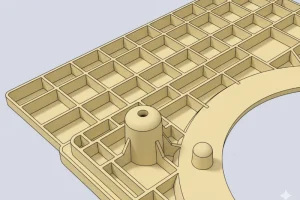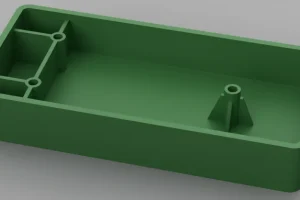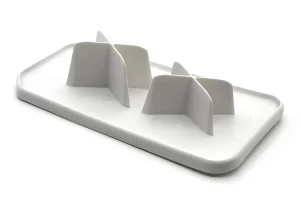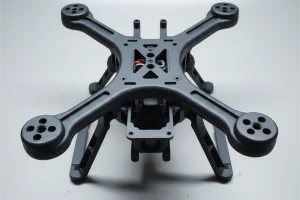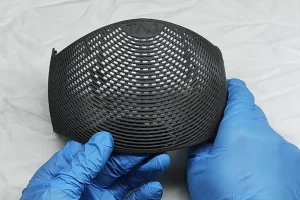Introduction: Injection molding is a widely used manufacturing process for producing high-volume parts with consistent quality. This technology involves injecting molten plastic into a metal mold cavity to determine the final shape of the product.
However, the conventional methods for making these molds can be both time-consuming and costly, particularly for small or custom production runs. Enter 3D printing, a cost-effective solution that allows manufacturers to swiftly produce molds with intricate geometries and fine details that were previously unachievable with traditional manufacturing techniques.

In this article, we will delve into the process of crafting 3D printed molds for injection molding.
Things to Note Before Choosing a 3D Printing Injection Mold
The success of the injection molding process relies heavily on the quality of the 3D printed mold. Factors such as print quantity and draft angle play a crucial role in the outcome, as discussed below:

Print Runs: It’s important to note that 3D printed injection molds, while cost-effective and efficient for low-volume production, have lower structural integrity compared to metal molds. Typically, these molds are viable for 30 to 100 runs, making them ideal for rapid prototyping purposes. For larger production volumes, traditional aluminum or steel molds may be more suitable.
Draft Angle: Incorporating the correct draft angle into the mold design is essential for seamless demolding of the injection molded part post-production. A recommended draft angle of 20 degrees facilitates the disassembly of molded parts, ensuring a smooth manufacturing proces

Size and Shape: Understanding the dimensions of the desired injection molded part is crucial when selecting the appropriate size and shape of the mold. Notably, 3D printed molds differ from CNC machined molds in terms of size, typically being smaller in scale. This size difference impacts the range of injection molded parts that can be produced using 3D printed molds compared to CNC machined counterparts.

Completed Flawlessly: The surface integrity of 3D-printed molds is occasionally inferior to that of metal injection molds due to the detrimental impact of high injection molding temperatures on mold performance. Consequently, these molds are not the optimal selection for projects necessitating a refined finish. Opting for an aluminum or steel injection mold is a superior alternative.

Alternatively, employing a shielding coating comprised of materials like ceramic on the printed mold can mitigate thermal degradation and aid in attaining a polished finish.
Create a CAD Design
The initial step in creating a 3D printed mold for injection molding is to design the mold using computer-aided design (CAD) software. Factors that should be considered during the design process include part geometry, molding material, gate location, and cooling channels.

To alleviate design challenges when creating a 3D printing mold, several tips can be beneficial. Firstly, selecting the appropriate mold material is critical. It is essential to ensure that the material chosen is robust and rigid enough to withstand the pressure generated during the injection process. Moreover, the mold’s melting point should exceed the melting point of the injection molding material.

Secondly, meticulous mold design is imperative for successful mold manufacturing. The inner surface of the mold should be positioned in a manner that prevents contact with the print carrier. Incorporating vents in the mold design can aid in the elimination of trapped air during the injection molding process, thereby reducing defects like porous parts. Additionally, integrating cooling channels into the mold design will facilitate a reduction in cooling time.

When designing your part, also consider incorporating a draft angle. Ensuring uniform wall thickness in formed parts and avoiding sharp corners are crucial factors to keep in mind. Injection molding flash is another important consideration; this occurs when extra material extrudes from the parting line of the extrusion die. To eliminate burrs, it’s recommended to include a runner system in the mold design. Moreover, post-design adjustments may be made, such as increasing clamping force and/or reducing injection pressure.

Design Mold
Material Options: To create a mold using 3D printing, one must take into account various factors including materials, components, injection molding defects, and more.

Numerous materials can be used for producing 3D printing injection molds, including PETG, ABS, nylon, PP, and acetal. When selecting the material for your 3D printing plastic mold, it’s crucial to consider the following two aspects:

Strength and Stiffness: Plastic polymers suitable for 3D printing injection molds need to exhibit strength and stiffness post-printing. These qualities are vital for enabling the mold to endure the stress generated during the injection process.

Temperature Resistance: As injection molding operates at elevated temperatures to facilitate optimal flow of molten plastic, it is imperative that the plastic material chosen for mold creation possesses a melting point higher than that of the injection molding material.

Mold Design: Strive to enhance dimensional accuracy by factoring in machining allowances on the mold for subsequent post-processing and resizing. Generate a series of molds to assess dimensional discrepancies and incorporate these variations into the CAD model of the molds.

Enhance mold longevity by opening the gate to alleviate pressure within the mold cavity. Ensure one side of the stack mold is flat while utilizing the other side for holding design components. This strategy helps mitigate mold block misalignment and the possibility of overflow.

Incorporate a sizable vent hole from the mold cavity edge to the mold edge for efficient exhaust. This aids material flow into the mold, decreases pressure, and prevents gate area flooding, thereby reducing cycle times. Steer clear of overly thin cross-sections, as surfaces with thickness less than 1-2mm are susceptible to deformation from heat.

Refine your printing process by adjusting the mold back to reduce material usage. Decrease the cross-sectional size of non-mold cavity supporting areas to cut resin expenses and diminish the likelihood of print defects or deformities. Introducing a chamfer can ease the removal of the workpiece from the build platform. Employ centering pins at the corners to align the two prints effectively.

Orientation of the Inner Face: Position the inner mold face to avoid any contact with supports, enhancing print surface quality by minimizing or eliminating support marks. This orientation also reduces the necessity for post-processing.

Shallow Vents: Incorporating vents into the mold design facilitates the removal of trapped air during the injection molding process. The recommended shallow vents, approximately 0.05 mm in size, help reduce the likelihood of defects such as injection flash.
Utilize Channels: Integrate channels into the mold design for molds intended for 20 or more runs. This allows for the inclusion of metal rods and tubes, effectively reducing injection molding defects like warping. Moreover, utilizing channels contributes to a decrease in cooldown time.

Layer Height: Opting for a lower layer height enhances the smoothness of the printed mold and minimizes the visibility of printed lines.

Parts Design: The quality of the injection molding process hinges significantly on the 3D printing mold utilized. Therefore, various factors must be taken into account during the part design phase to ensure the success and efficiency of the printed product, including the incorporation of a draft angle. A recommended draft angle of 20 simplifies the removal of the injection molded part from the printed injection mold.

Material Selection: The choice of material for the 3D printed mold is critical. It should be capable of enduring the elevated temperatures and pressures involved in the injection molding process without warping or melting. Materials like nylon, ABS, and polycarbonate are frequently employed for 3D printing injection molds.

Uniform Wall Thickness: Injection-molded parts require consistent wall thickness to minimize defects such as warping during and after injection. In cases where thin walls are necessary, incorporating thin ribs and gussets can enhance wall strength.
Avoid Sharp Corners: I have included radius on the edges of the mold to eliminate sharp corners. This adjustment helps to facilitate the smooth flow of molten plastic and reduces the occurrence of injection molding defects.

Prevent Flash: Flash is a common issue in injection molding, where excess molten plastic escapes the mold and solidifies during the injection process. This defect can result from a poor fit between mold halves, excessive injection pressure, or mold overfilling.

Flash from 3D printed molds can be eliminated by incorporating runner systems into the mold design and ensuring tolerances on part lines. However, if these methods don’t work, you can try making post-design adjustments, such as increasing the clamping force and/or reducing the injection pressure.

Use Release Compound to Remove Parts: A release agent is introduced during the demoulding process to aid smooth removal of the injection-molded part. Without a release agent, parts can get stuck in the mold. This will require excessive force to remove the part, which may damage the part and/or the mold.

Testing and Verification: Before using a 3D printed mold for injection molding, its performance must be tested and verified. Testing can help identify any issues with mold design or material selection and make necessary adjustments before part production begins.

Export CAD Design Files
After creating the CAD model of the mold, the subsequent step involves exporting the design as an STL file. STL is a commonly used file format for 3D printing. The STL file encompasses a 3D model of the mold, ready to be imported into 3D printing software in readiness for printing. Additional file formats compatible with 3D printers include FBX, OBJ, 3MF, PLY, G-Code, X3G, and AMF.

3D Printing Injection Mold
Once the STL file is prepared, a 3D printer can be used to produce the injection mold. Molds can be created through various 3D printing processes, such as Fused Deposition Modeling (FDM), Stereolithography (SLA), Selective Laser Sintering (SLS), and Digital Light Processing (DLP). The selection of the 3D printer and printing materials depends on factors like the complexity of the mold and the mold’s longevity.

FDM typically presents the most cost-effective 3D printing solution for plastic molds and tooling. Nevertheless, the final mold may exhibit visible layer lines that necessitate sanding or chemical finishing for removal.

Resin-based 3D printing technologies like SLA and DLP are popular choices as they yield molds with smoother surface finishes, reducing the need for extensive post-processing. Material jetting, another resin-based 3D printing method, can craft molds with superior surface finishes using various materials and colors. SLS utilizes reinforced nylon for mold production, offering robust strength and high surface quality.

Standard Configuration
3D printing molds for injection molding mainly have the following two standard configurations.

Furnished 3D Printing Mold
This setup does not necessitate aluminum support frames since they are entirely printed. As a result, the mold demands more printing material, escalating both the printing cost and time. Nevertheless, sans a frame, they are susceptible to defects like warping following extensive use.

Mount the Mold to the Metal Frame
Once the 3D printed mold is complete, it must be mounted into a metal frame (mold base) to hold it in place during the injection molding process. The mold base includes the sprue bushing, where molten material is poured into the mold.

The configuration of the mold determines how it is mounted to the frame. There are two standard configurations of injection molds for 3D printing. The first configuration inserts the printed mold into an aluminum frame, providing stability, accuracy, and support to the mold. This configuration is more suitable for producing precise injection molded parts, helps prevent molding defects such as warping, maintains the integrity of the mold, and ensures consistent pressure distribution during the injection molding process.

The second configuration entails a fully 3D-printed mold without an aluminum frame. Although this removes the necessity for a frame, it necessitates more printing material, leading to increased printing costs and time. Molds created using this configuration are also more susceptible to defects like warping, as support is lacking.

Start the Injection Molding Process
Once the mold is mounted on the metal frame, the injection molding process can commence. During this process, the mold is closed and molten material is injected into the mold through the sprue sleeve. The molten material fills the mold cavity, conforming to the shape of the intended part. Upon cooling and solidification of the material, the mold is opened, and the finished part is extracted.

Post-Processing
After printing, the mold may require additional post-processing. This can include sanding to remove layer lines, assembling multiple prints, and applying a release agent to the surface of the cavity to help release the finished part after injection molding.

Sanding: Sanding can help eliminate layer lines on the surface of the 3D printed model. Begin with coarser sandpaper and gradually switch to finer grits. Avoid sanding in the same spot for too long to prevent excessive friction and heat that may melt the surface. Be cautious not to sand away too much material, especially around seams if the print needs to be bonded later.

Bonding: When gluing, it is recommended to apply glue in small dots to ensure closer contact between the two surfaces, akin to binding them with a rubber band. For rough or gapped seams, Bondo glue or filler can be used to achieve a smoother finish.

Coloring: During this step, try to do it in a well-ventilated and dust-free area to ensure the coloring is even on all surfaces. When spraying, hang the target while keeping a distance of an arm’s length. After painting the soft glue 3D printing model, allow 1-2 days for it to dry before polishing.
Installing Screw Slots: Installing screw slots can extend the service life of the 3D printed shell. To ensure a tight fit, the holes on the model should be slightly smaller than the screw slots. Secure the model for stability and avoid fast or forceful operations to prevent deformation of the holes.

Silicone Mold Flipping: This process involves a 3D printing mold box, silicone, resin, measuring cup, and other materials. To calculate the mold volume, fill the 3D printing mold box with water first, then pour the water into the measuring cup.
Conclusion
3D printed molds offer a distinct advantage over traditionally designed molds, making them ideal for various industries requiring small batch production of both simple and intricate product designs.

In essence, the process of creating 3D printed molds for injection molding follows a structured approach. It commences with designing the mold using CAD software and proceeds to fine-tune printer settings to achieve high-quality prints. Subsequent post-processing steps, such as grinding and polishing, may be necessary to enhance the mold’s surface.
Incorporating essential components, like plug-ins, and conducting comprehensive testing ensure functionality and precision. Once validated, the mold is primed for injection molding production, facilitating the rapid prototyping and manufacturing of plastic parts with intricate designs.


